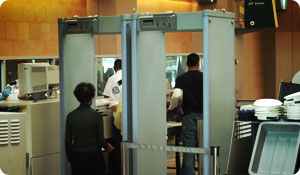
The use of new x-ray scanners to screen airline passengers has sparked vigorous debate on the safety and need for this level of screening.
Proponents argue the screeners have been thoroughly tested and vetted by regulating bodies such as the Food and Drug Administration. Opponents believe they expose travelers to higher-than-reported levels of radiation, which put some people at greater risk of developing cancer.
Backscatter Machines
The new scanners, called backscatter machines, look for metallic and non-metallic threats (for example, weapons and explosives) that airline passengers may try to conceal under their clothing. The backscatter scanners employ Advanced Imaging Technique (AIT), which uses low doses of ionizing radiation to create an image of the body that looks like a chalk drawing. Ionizing radiation is energy that travels as waves or high-speed particles that bounce off the skin.
Concerned scientists, including a group from the University of California (UC), are worried about the potential health risks of the radiation and have urged the White House to delay using the screening until they can study their safety more thoroughly. The Transportation Safety Administration's response is that "the potential health risks from full-body screening with a general use X-ray security system are minimal."
So what are consumers to believe? Is the radiation from the screeners safe or not?
Health Concerns around the New X-Ray Machines
Women who have mutations in the breast cancer susceptibility gene, BRAC2, may be at greater risk of developing cancer from exposure to radiation. When exposed to environmental that damage DNA, such as radiation, it increases their risk for cancer. Jason Bell, a molecular biologist and biophysicist, writes on his blog that over time, incremental exposure to small and seemingly safe doses of ionizing radiation statistically accumulate and the damage increases the probability of cancer.
The radiation energy from the screener is the same for everyone, so the relative absorbed dose is twice as high for small children and infants because they have smaller body mass. Furthermore, backscatter machines use both hard and soft x-rays. Our body absorbs more of the soft x-rays, so the biologically relevant dose is higher.
The UC scientists are also concerned that other groups of travelers may be at greater risk of radiation harm than the general population, including older travelers and those who have a compromised immune system.
All concerned parties fear there is not enough research to establish the medium and long-term safety of this type of screening.
Sources:
Bell, Jason. "Review of the TSA X-ray backscatter body scanner safety report: hide your kids, hide your wife." My Helical Tryst blog. Web. 22 November 2010. http://myhelicaltryst.blogspot.com/2010/11/tsa-x-ray-backscatter-body-scanner.html
Sedat, John, Agard, David, Shuman, Marc, and Stroud, Robert. Letter of concern to the White House. Web. 6 April 2010. http://www.whitehouse.gov/sites/default/files/microsites/ostp/ucsf-jph-letter.pdf
Steenhuysen, Julie. "Radiation Risk Low With Whole-Body Airport Scanners." Medscape Medical News. Web. 6 January 2010. http://www.medscape.com/viewarticle/714753
Transportation Security Administration. "Advanced Imaging Technology (AIT)." Web. http://www.tsa.gov/approach/tech/ait/index.shtm
Transportation Security Administration. "Advanced Imaging Technology: "Radiation Risk Tiny." TSA Blog. Web. 11 March 2010. http://blog.tsa.gov/2010/03/advanced-imaging-technology-radiation.html
Greenberg, Peter. "The Facts About TSA Body Scanners." AARP. Web. 23 November 2010.





